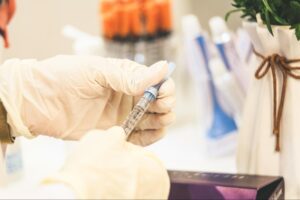How Much HGH Should Women Take?
In recent years, there has been an increase in demand for drugs aimed at boosting human growth hormone levels in women. What could be the reason for this? Actually, the composition of human growth hormone is rich in amino acids and important elements that are effective in anti-aging, weight loss, and improving metabolism.
The correct HGH dosage for women can provide many benefits that are difficult to achieve on your own. However, what dosage is considered safe? How do you choose the right amount of the drug to achieve results and avoid side effects at the same time? In this article, we will tell you more about human growth hormone injections, dosage selection, and their effects on the female body!
What Is HGH and Why Do Women Use It?
So, HGH is one of the main hormones in the body (in both men and women). Men usually use it to increase muscle mass, while ladies choose it for its anti-aging benefits. It helps restore skin elasticity, improve metabolism, and boost energy.
The effectiveness of HGH among women in medicine has been repeatedly proven in real studies. However, it is necessary to find the right HGH dose for females to avoid potential effects and improve the results of the course. Later in this article, we will share with you specific dosages for each possible scenario.
Optimal HGH Dosage for Women – How Much Should You Take?
There is no one number that is your optimal HGH range, you find this by steps. The recommended HGH dose for women begins with a dose of 0.2-0.3 mg or approximately 0.6-0.9 IU per day. Start at a low level because your body will adapt, and you will be able to restrict the side effects. During the first 1-2 months, your clinician will need to monitor the symptoms and the lab. When you are responding effectively, they will increase the dose by 0.1-0.2 mg at a rate of 1-2 months until you achieve the desired response without adverse effects.
Practically, the mean maintenance range comes to 0.4-0.8 mg/day (approximately 1.2-2.4 IU), but your own level is determined by health condition, objectives, and your metabolism of the hormone. Keep an eye on fluid retention, tingling, headache, and stiffness of the joints. This is a possible indicator that you must either take a break in increasing or take a step backward. Optimal HGH doses for women may change with age, body mass, thyroid conditions, and insulin insensitivity. We advise you to apply medical supervision, dosing judiciously, and regular retesting of labs to maintain IGF-1 within the target range of your provider. The majority of programs involve daily subcutaneous injections; regularity at the same time of the day is important in stabilizing the levels, and easier side effects are identified.
Factors That Affect HGH Dose for Females
There are many factors influencing the choice of a particular drug. However, there are no fewer things that affect the choice of a specific dosage. What do we mean? For example, the specific HGH dosage for women may vary depending on your goal (improving metabolism or combating signs of aging). Other influencing factors include:
- Age.
- Body weight.
- Current hormone levels in the body.
Dosage is an individual matter, so you should consult a medical expert before taking the drug (even if you don’t consider yourself a beginner). Moreover, doses of drugs aimed at increasing human growth hormone levels for women are always lower than doses for men.
HGH Dosage Schedule and How to Take It Safely

Women usually begin the course with self-injections 1x per day. It can be made either in the morning on an empty stomach or 30-60 minutes before sleep. Bedtime dosing is a reflection of the natural nighttime GH pulse. Morning is needed to train early or in cases where sleep is a sensitive issue.
A 5/2 days off schedule is permitted by many clinicians to minimize fluid retention and cost, whereas many use it daily. Change position (abdomen, outer thigh, back of arm) and employ new needles in a sterile manner. Take the HGH dose for women as prescribed by your clinician.
What else? Begin with a 3-6 months course and appraise after every 4-8 weeks. Your provider is to monitor symptoms and lab tests, in particular IGF-1, fasting glucose, and thyroid. When you are doing well, you make little and gradual adjustments. We mean scale down or stop because of edema, tingling, headaches, or stiffness of the joints.
When Do Women Start Seeing Results from HGH?

The majority of women observe the initial changes in 4-6 weeks. Nighttime sleep is more beneficial and better, constant energy in the daytime, and skin changes, such as moisture and smoothness. However, changes in strength, recovery, and body composition are slower. Higher levels of visible results are usually achieved after 3-6 months with the effects of regular dosing, training, nutrition, and, within the IGF-1 range, a decrease in fat, muscle tone, and performance. The schedules are dependent on age, initial health, and compliance.
Benefits of HGH for Women
Under the right prescription and oversight, HGH may promote body structure, muscle healing, and a healthy range of vitality. Responses are slow and are determined by the quality of sleep, protein consumption, resistance exercise, and thyroid or insulin congenital status. Reported benefits include clinician-observed benefits in adult women who are using physiologic replacement ranges:
- More hydrated skin that is smoother with fewer lines.
- Fat mobilization, particularly visceral fat or abdominal fat.
- Quicker recovery of the muscles and the enhancement of exercise tolerance. Increased libido and sexual performance.
- Positive mood, motivation, and cognitive drive. More coherent and profound sleep.
The effects can only be realized when one gets the right doses, products of known quality, and frequent labs to maintain IGF-1 on target. Backdosing leads to fluid retention, pain in the joints, and a rise in glucose. Therefore, titration should be gradual, personalized, and under the guidance of a doctor.
Possible Side Effects of HGH in Women
The most probable side effects of HGH are in case of excessive increase in the dose. Common ones are fluid retention or edema (swollen fingers, ankle swelling), joint or muscle pain, carpal-tunnel-tingling, morning headaches, and temporary rises in fasting glucose or insulin resistance. Other women experience bloating or a slight increase in blood pressure. These normally get better as the dose is lowered or stopped.
Prevention revolves around disciplined dosing and monitoring. Initiate low, increase in small steps at 4-8-week intervals, and bear in mind a 5-days-on/2-days off rhythm in case of retention. Change injecting sites and maintain a schedule. Your clinician must monitor symptoms as well as labs-IGF-1, fasting glucose or A1C, lipids, and thyroid, and will make changes. Re-evaluate after every 1 to 2 months, and have a rest once the side effects are continuously present.
HGH Supplements and Natural Alternatives for Women

Before buying a certain drug and calculating the HGH dose for women, you should think about whether you have tried all the methods. Many people do not know that human growth hormone levels can be increased naturally using certain techniques. For example, review your daily diet and create a special healthy diet plan. Your menu should include foods that promote the increase of this hormone.
Another effective method is to establish a strong and deep sleep pattern, which should last about 8 hours a day to ensure the normal functioning of the body. Also, combine this with regular exercise and taking peptides and beneficial amino acids. Only a comprehensive approach will help you achieve your goal, whether it is fighting aging, improving metabolism, or losing weight.
Finding the Right HGH Dose for Women
As you may have already understood, the correct HGH dosage for women is highly significant for the final result and safety of the entire treatment course. That is why you should devote more time to selecting the correct amount of the drug and discussing it with your doctor in advance. The final values may vary from case to case, as the dosage is determined by age, goals, current condition, and other factors.
